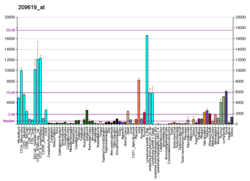Function
The nascent MHC class II protein in the rough endoplasmic reticulum (RER) binds a segment of the invariant chain (Ii; a trimer) in order to shape the peptide-binding groove and prevent the formation of a closed conformation.
The invariant chain also facilitates the export of MHC class II from the RER in a vesicle. The signal for endosomal targeting resides in the cytoplasmic tail of the invariant chain. This fuses with a late endosome containing the endocytosed antigen proteins (from the exogenous pathway). Binding to Ii ensures that no antigen peptides from the endogenous pathway meant for MHC class I molecules accidentally bind to the groove of MHC class II molecules. [10] The Ii is then cleaved by cathepsin S (cathepsin L in cortical thymic epithelial cells), leaving only a small fragment called CLIP remaining bound to the groove of MHC class II molecules. The rest of the Ii is degraded. [10] CLIP blocks peptide-binding until HLA-DM interacts with MHC II, releasing CLIP and allowing other peptides to bind. In some cases, CLIP dissociates without any further molecular interactions, but in other cases the binding to the MHC is more stable. [11]
The stable MHC class II + antigen complex is then presented on the cell surface. Without CLIP, MHC class II aggregates disassemble and/or denature in the endosomes, and proper antigen presentation is impaired. [12]
This page is based on this
Wikipedia article Text is available under the
CC BY-SA 4.0 license; additional terms may apply.
Images, videos and audio are available under their respective licenses.









